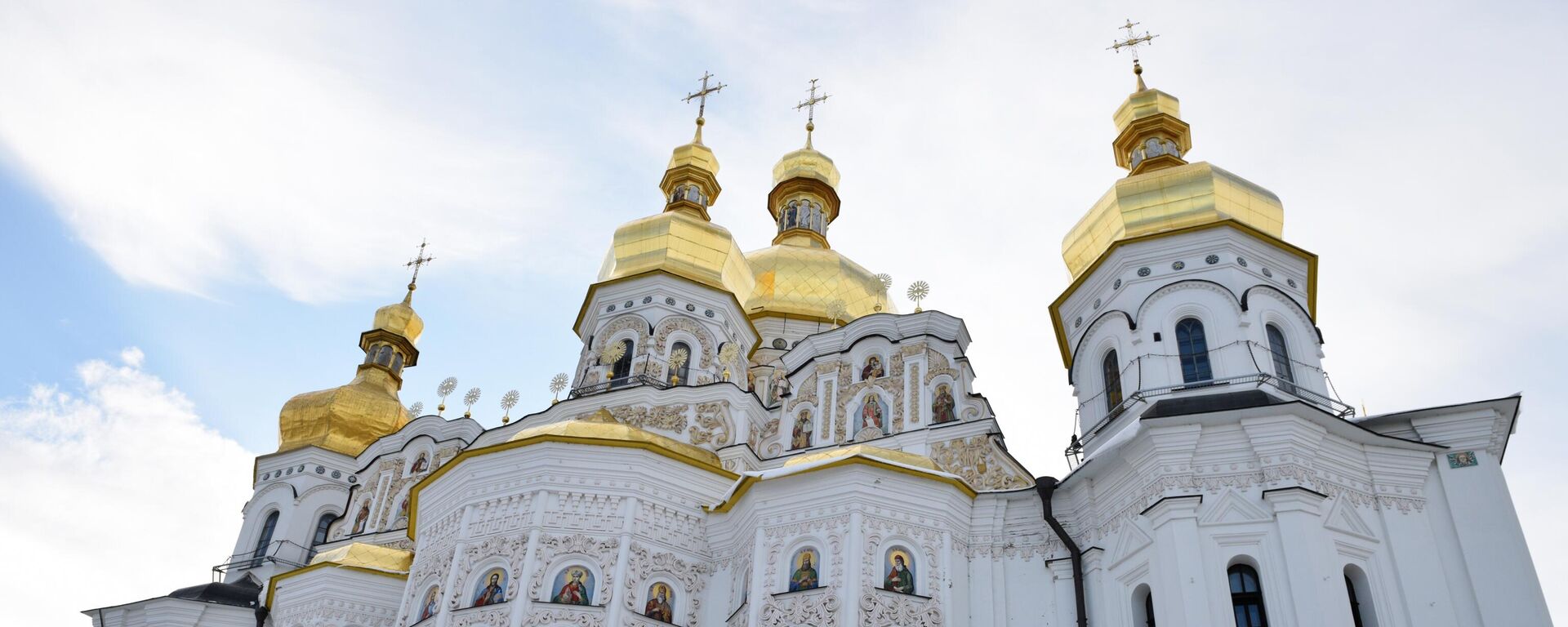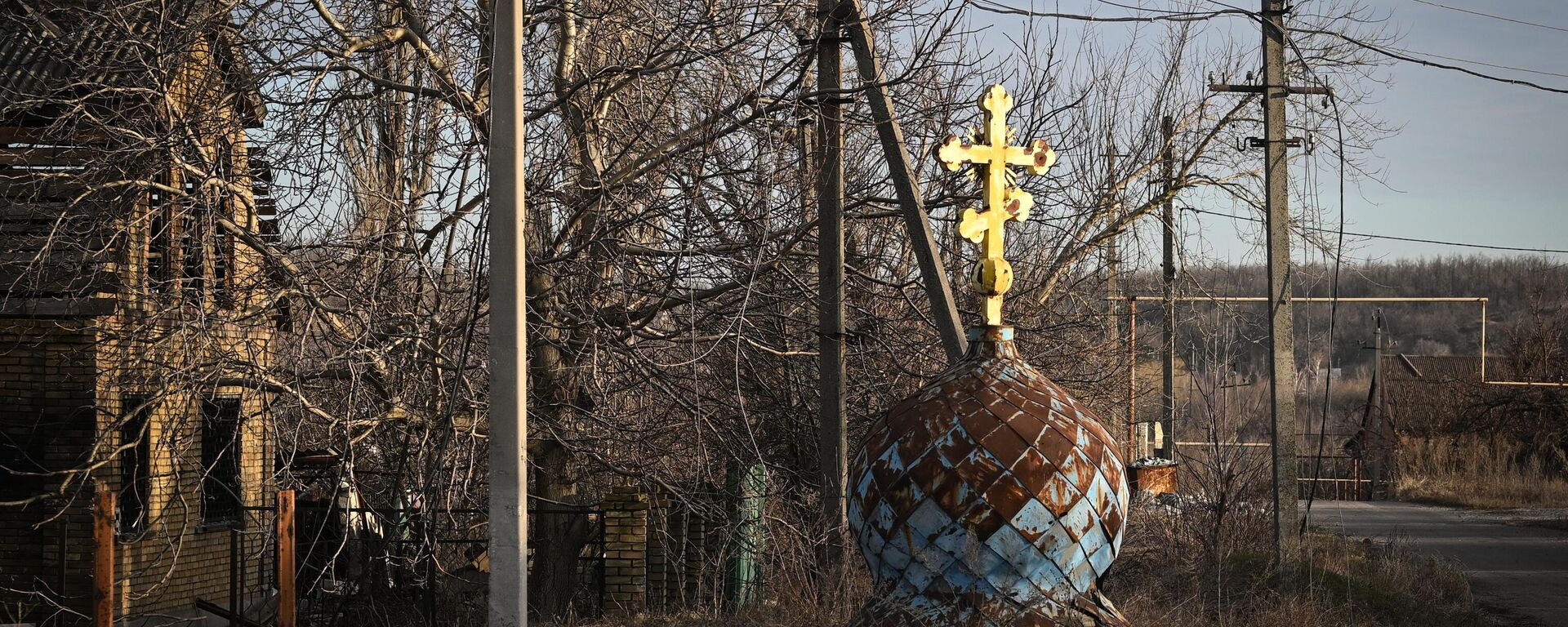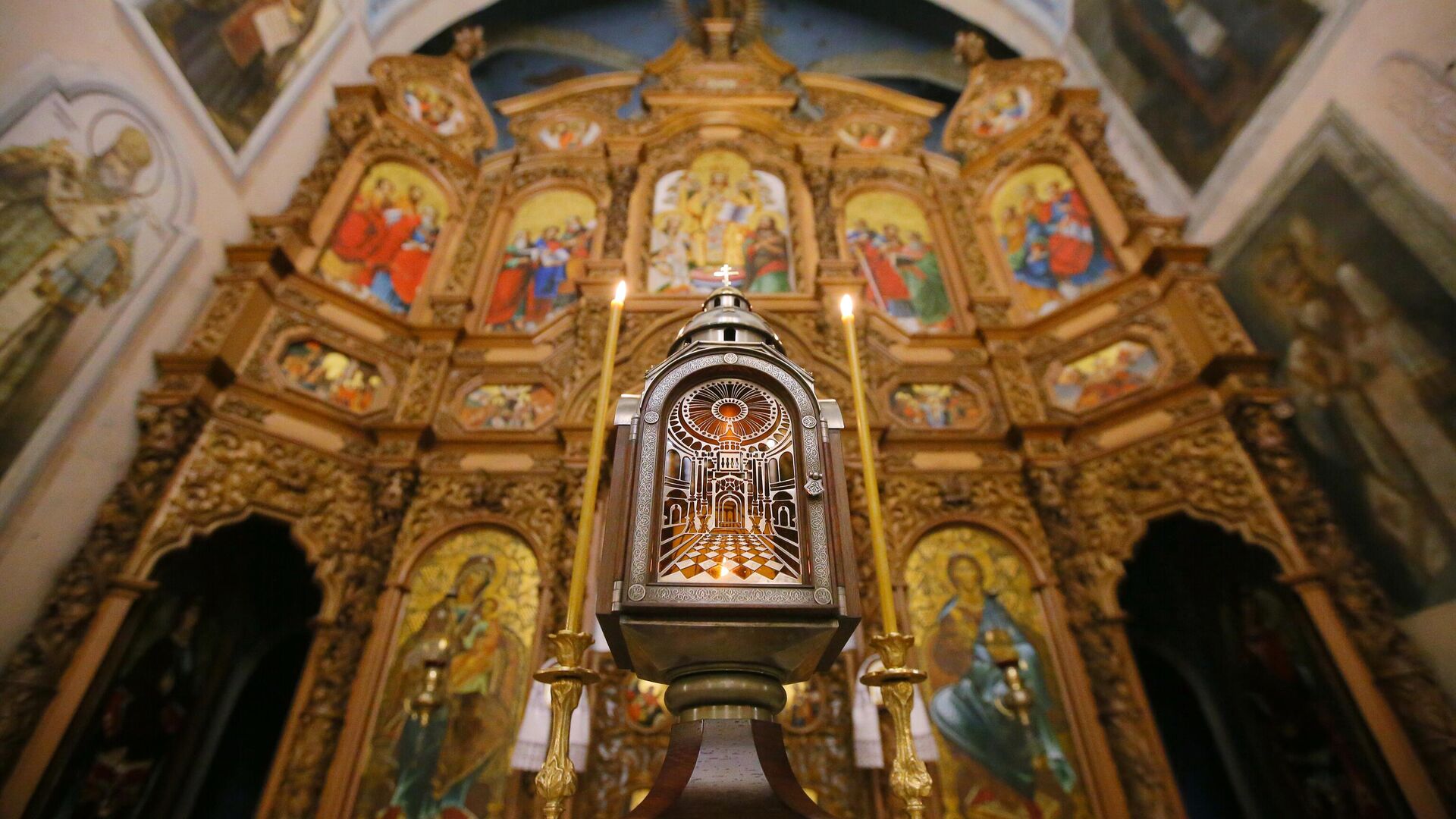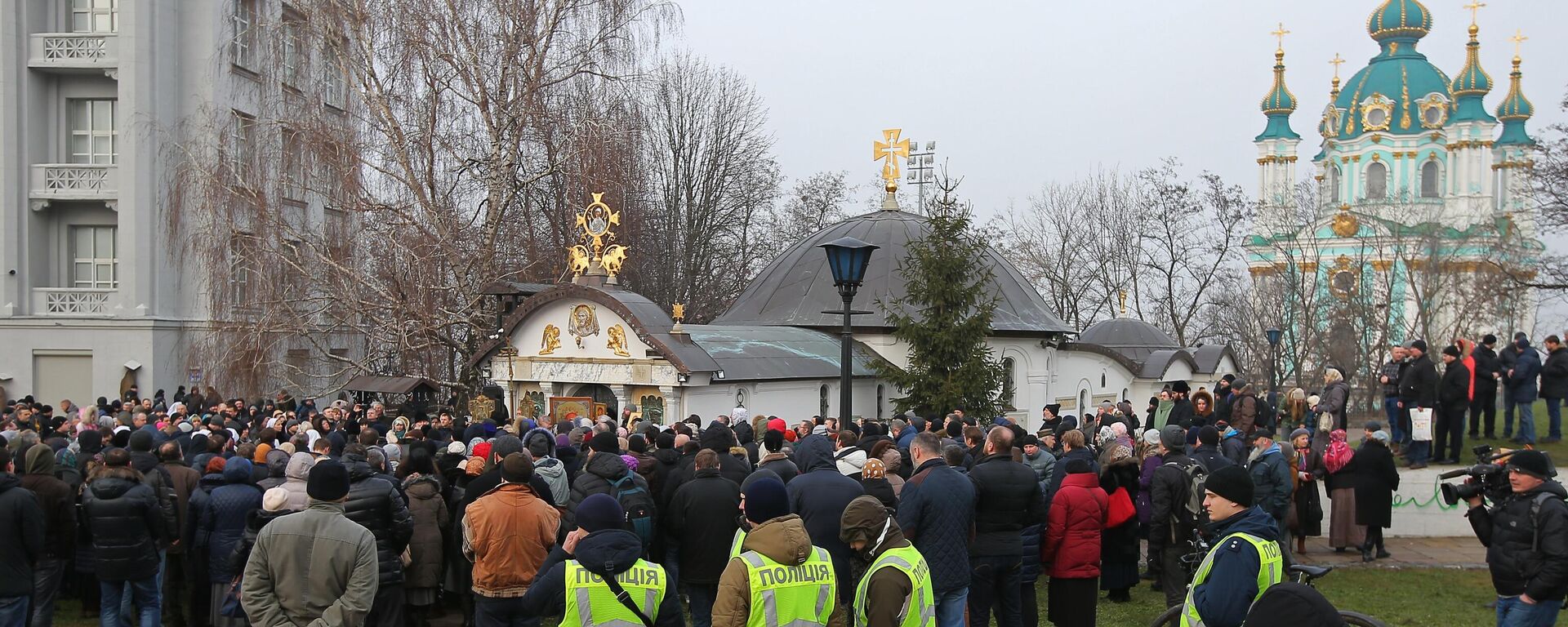https://sputnikglobe.com/20240823/ukraine-sells-orthodox-heritage-out-to-west-but-wait-its-russian-1119881246.html
Ukraine Sells Its Orthodox Heritage Out to West. But Wait, It’s Russian
Ukraine Sells Its Orthodox Heritage Out to West. But Wait, It’s Russian
Sputnik International
The Kiev regime tends to view its common religious heritage with Russia as exclusively Ukrainian and sells to the West invaluable Christian artifacts, religion expert Roman Lunkin told Sputnik.
2024-08-23T09:48+0000
2024-08-23T09:48+0000
2024-08-23T09:50+0000
world
europe
maria zakharova
petro poroshenko
kiev
ukraine
russia
russian academy of sciences (ras)
russian foreign ministry
louvre
https://cdn1.img.sputnikglobe.com/img/07e7/03/0b/1108292784_0:160:3073:1888_1920x0_80_0_0_f7f716c636aeaf50aba05c65c0c52179.jpg
Historical and cultural artifacts, including Orthodox icons, are taken out of Ukraine and transferred to Western countries where some of them are sold, according to Roman Lunkin, head of the Center for the Study of Religion and Society of the Institute of Europe at the Russian Academy of Sciences (RAS).Last year, the rarest 6th and 7th-century Byzantine icons were secretly transferred from the territory of Ukraine to France under the pretext of safety issues, and then displayed at the Louvre Museum in Paris. All in all,16 invaluable artifacts were brought to France through Poland and Germany.Still, the crux of the matter is that these Christian Orthodox icons were gifted to the head of the Russian Ecclesiastical Mission in Jerusalem by the Sinai Monastery of St. Catherine in the mid-19th century, according to Bishop Porfiry, a Russian theologian and byzantinologist.In 1940, the Soviet government transferred the icons to the Kiev Museum of Western and Oriental Art (now known as the Khanenko Museum of Art), where they were kept after the Great Patriotic War. It is unclear whether and when the icons will be returned.On June 26, 2023, Russia’s Foreign Intelligence Service (SVR) reported on Kiev's plans to remove Christian valuables and relics from the Kiev-Pechersk Lavra, and send them to Europe under the pretext of "saving them from Russian missile attacks", despite the fact Russian forces are not targeting civilian facilities, let alone Orthodox holy places.Still, there is more to the Kiev regime's readiness to squander its heritage, and the West's eagerness to keep Ukraine's Christian valuables under the auspices of the International Alliance for the Protection of Heritage in Conflict Areas (ALIPH), chaired and overseen by US billionaires.Russian Foreign Ministry Spokeswoman Maria Zakharova last year linked the alleged plot, described by the SVR, as well as the secret removal of Byzantine icons from the Kiev museum, to the old Western colonial trend:The problem is that the Kiev regime considers this historical and cultural heritage "exclusively Ukrainian", regardless of its true origin, Lunkin underscored.The Kiev-Pechersk Lavra was founded in 1051, during the rule of the Russian Duke Yaroslav the Wise, who reigned in Rostov, Novgorod, and later in Kiev. The Lavra has always been considered part of the common historical and religious heritage of Russians and Ukrainians. However, in the aftermath of the 2014 coup in Ukraine, which illegitimately brought to power Western-backed nationalist authorities, the Kiev regime doubled down on creating a separate "Ukrainian history" to "appropriate" the Kievan Rus history.In May 2017, then President Petro Poroshenko claimed that Duke Yaroslav and his daughter, Anna, who became Queen of France in 1051 upon marrying King Henry I, were "Ukrainians", regardless of the fact that this East Slavic ethnic group had not been formed at that time.Volodymyr Zelensky has gone even further, according to Lunkin. In addition to creating a myth about a separate Ukrainian history and a separate Ukrainian Orthodoxy, "the Ukrainian authorities and the Orthodox Church of Ukraine (OCU), which they created [in 2018], are trying to separate the saints, who were born on the territory of modern Russia," the pundit pointed out.
https://sputnikglobe.com/20240822/western-globalist-vultures-set-to-prey-on-ukraines-orthodox-treasures-1119876329.html
https://sputnikglobe.com/20240821/ukraines-bill-outlawing-canonical-orthodox-church-fits-wests-globalist-agenda---psyop-veteran-1119857967.html
https://sputnikglobe.com/20240517/centuries-old-historic-ukrainian-orthodox-chapel-torn-down-in-kiev--1118491572.html
kiev
ukraine
russia
Sputnik International
feedback@sputniknews.com
+74956456601
MIA „Rossiya Segodnya“
2024
News
en_EN
Sputnik International
feedback@sputniknews.com
+74956456601
MIA „Rossiya Segodnya“
Sputnik International
feedback@sputniknews.com
+74956456601
MIA „Rossiya Segodnya“
ukraine banned ukrainian orthodox church, kiev regime takes christian relics and icons out of ukraine, ukraine sells orthodox icons in the west, byzantine icons in louvres, kievan rus, ukraine re-writes kievan rus' history, russian history, ukrainian ethnicity
ukraine banned ukrainian orthodox church, kiev regime takes christian relics and icons out of ukraine, ukraine sells orthodox icons in the west, byzantine icons in louvres, kievan rus, ukraine re-writes kievan rus' history, russian history, ukrainian ethnicity
Ukraine Sells Its Orthodox Heritage Out to West. But Wait, It’s Russian
09:48 GMT 23.08.2024 (Updated: 09:50 GMT 23.08.2024) The Kiev regime tends to view its common religious heritage with Russia as exclusively Ukrainian and sells to the West invaluable Christian artifacts, religion expert Roman Lunkin told Sputnik.
Historical and cultural artifacts, including Orthodox icons, are taken out of Ukraine and transferred to Western countries where some of them are sold, according to Roman Lunkin, head of the Center for the Study of Religion and Society of the Institute of Europe at the Russian Academy of Sciences (RAS).
"It is not rational and not at all ethical to treat the heritage this way," Lunkin told Sputnik.
Last year, the rarest 6th and 7th-century Byzantine icons were secretly transferred from the territory of Ukraine to France under the pretext of safety issues, and then displayed at the Louvre Museum in Paris. All in all,16 invaluable artifacts were brought to France through Poland and Germany.
Still, the crux of the matter is that these Christian Orthodox icons were gifted to the head of the Russian Ecclesiastical Mission in Jerusalem by the Sinai Monastery of St. Catherine in the mid-19th century, according to Bishop Porfiry, a Russian theologian and byzantinologist.
In 1940, the Soviet government transferred the icons to the Kiev Museum of Western and Oriental Art (now known as the Khanenko Museum of Art), where they were kept after the Great Patriotic War. It is unclear whether and when the icons will be returned.

22 August 2024, 19:07 GMT
On June 26, 2023, Russia’s Foreign Intelligence Service (SVR) reported on Kiev's plans to remove Christian valuables and relics from
the Kiev-Pechersk Lavra, and send them to Europe under the pretext of "saving them from Russian missile attacks", despite the fact Russian forces are not targeting civilian facilities, let alone Orthodox holy places.
Still, there is more to the Kiev regime's readiness to squander its heritage, and the West's eagerness to keep Ukraine's Christian valuables under the auspices of the International Alliance for the Protection of Heritage in Conflict Areas (ALIPH), chaired and
overseen by US billionaires.
Russian Foreign Ministry Spokeswoman Maria Zakharova last year
linked the alleged plot, described by the SVR, as well as the secret removal of Byzantine icons from the Kiev museum, to the old Western colonial trend:
"Western countries have stolen national valuables throughout the world, and their museums can be described as the 'safekeepers' of valuables stolen from their colonies, as you can see in the Ancient Egypt exhibit in the Louvre or the British Museum… The West has always plundered its colonies. Ukraine is no exception. There is no doubt that no one was going to return the valuables they had taken away from other countries," Zakharova stressed.

21 August 2024, 13:03 GMT
The problem is that the Kiev regime considers this historical and cultural heritage "exclusively Ukrainian", regardless of its true origin, Lunkin underscored.
"Icons that are kept in the [Kiev-Pechersk] Lavra and other museums, including cultural monuments in Ukraine, are the common property of Russian culture and the culture of Kievan Rus, which was created from the moment of the Baptism of Russia more than 1000 years ago. Accordingly, this is the common and inseparable heritage of our countries because it was created at a time when Rus existed, before Ukrainians and Ukraine did. Therefore, it is wrong to call these icons exclusively Ukrainian," the pundit said.
The Kiev-Pechersk Lavra was founded in 1051, during the rule of the Russian Duke Yaroslav the Wise, who reigned in Rostov, Novgorod, and later in Kiev. The Lavra has always been considered part of the common historical and religious heritage of Russians and Ukrainians. However, in the aftermath of the 2014 coup in Ukraine, which illegitimately brought to power Western-backed nationalist authorities, the Kiev regime doubled down on creating a separate "Ukrainian history" to "appropriate" the Kievan Rus history.
In May 2017, then President Petro Poroshenko claimed that Duke Yaroslav and his daughter, Anna, who became Queen of France in 1051 upon marrying King Henry I, were "Ukrainians", regardless of the fact that this East Slavic ethnic group had not been formed at that time.
Volodymyr Zelensky has gone even further, according to Lunkin. In addition to creating a myth about a separate Ukrainian history and a separate Ukrainian Orthodoxy, "the Ukrainian authorities and the Orthodox Church of Ukraine (OCU), which they created [in 2018], are trying to separate the saints, who were born on the territory of modern Russia," the pundit pointed out.
"We are now witnessing an attempt to divide history and divide saints into right and wrong, as well as to divide believers into right and wrong, within the framework of the ban on the Ukrainian [Orthodox] Church [UOC]," he concluded.





